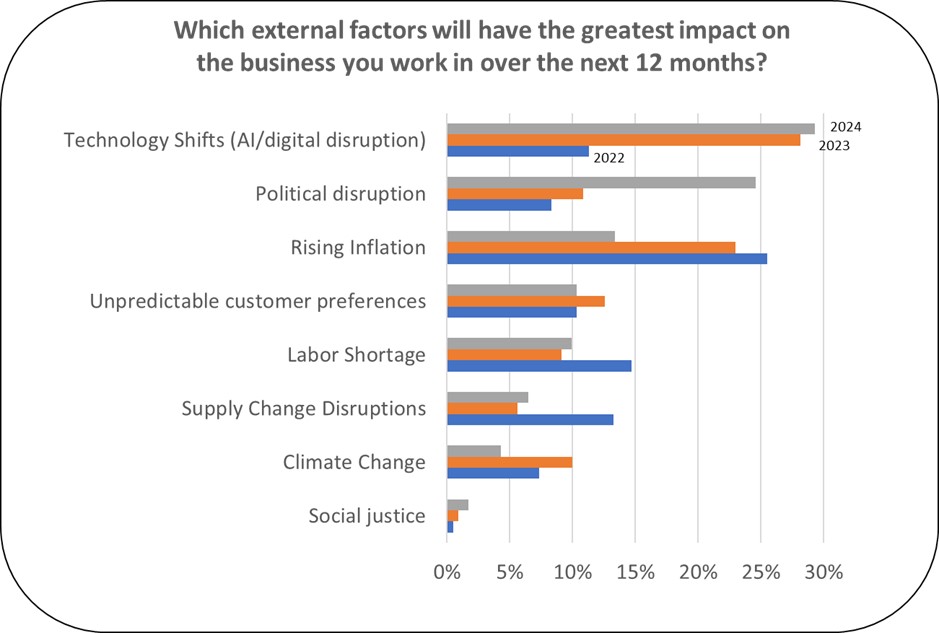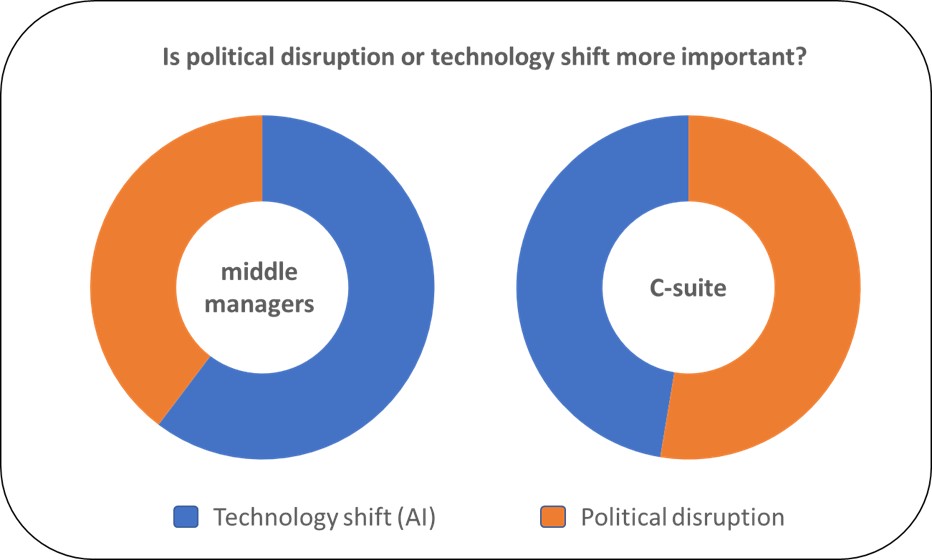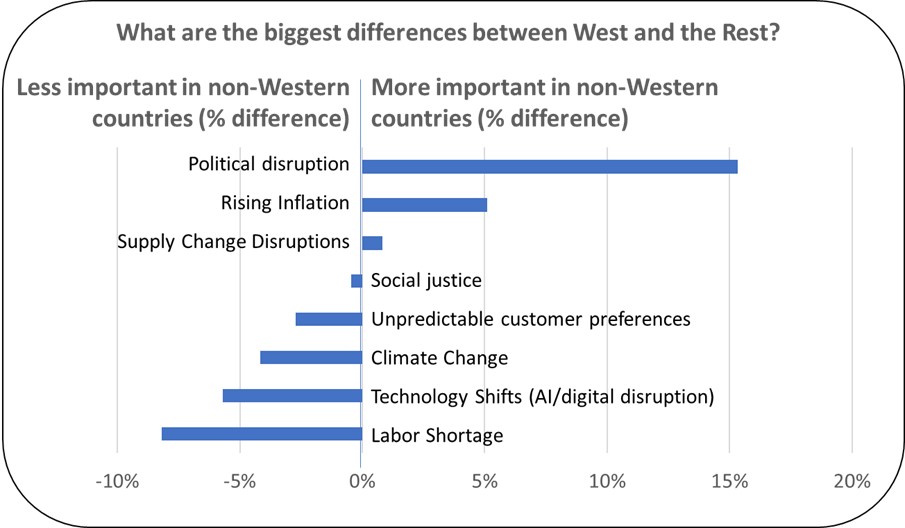
Check in: Executives and middle managers are focused on different challenges for 2025
The most googled question of 2024 was: “What to watch?” So, I decided to ask business leaders a similar question. What trends should we watch for during the year ahead?
Keeping up with the shifting landscape is vital for strategists. Their ideas do not exist in a vacuum.
In keeping with my annual custom, I reached out to my Warwick Business School network of C-suite executives and middle managers to discover which challenges top their agenda.
Executives make the big decisions, but middle managers need to implement them. Both will play a vital role in helping companies to respond effectively to the challenges that will define 2025.
I received 232 responses - half from senior executives, the rest from middle managers and specialist staff. Three graphs summarise the most interesting insights from the survey.
How have the challenges facing business changed?
Donald Trump has just won the US election, a wider war in the Middle East is not off the table, and Ukraine continues to fight the Russia invasion.
Therefore, it comes as no great surprise that political disruption is high up the list.
However, the number one challenge remains the need to adjust to technology shifts. This issue rose to the top of corporate agendas last year when the generative AI hype was in full bloom.

Companies recognise that there is a substantial shift in terms of technology, but there is also a growing frustration that AI is not delivering what the initial hype promised.
This is common for new technologies. The real benefits will only come with specific applications and the adjustment of business processes.
This is where executives can make a real difference. Creating the space – maybe even forcing – their teams to experiment will help to create new ways of integrating AI in an effective manner.
As far as political disruption is concerned, companies need to invest considerable time and money into lobbying.
The assumption that markets are rational has always been wrong, but that has probably become more obvious recently.
Taking a stand on sensitive issues will often be unavoidable. The good news is that if a company comes across as authentic it usually does not hurt sales.
For example, Nike is known for its progressive views and fast-food chain Chick-fil-A has strong conservative roots. Flip-flopping can cause far bigger problems by alienating your audience.
The good news is the lower inflation rates that analysts are anticipating will make it easier to invest in initiatives to tackle both technological shifts and political disruption.
My survey revealed one other, less obvious, insight. Supply chain disruption, climate change, and social justice are considered to be the least important factors in 2025.
As strategy is all about finding anomalies that others don’t see, there might be overlooked
opportunities in this space.
Middle managers and C-suite executives have different priorities
While the top challenge has changed since the survey was first initiated three years ago, the one
constant has been that C-suite executives and middle managers have different priorities.
This year middle managers see technology shift as the top trend and political disruption as number two. For executives the order is reversed.

That difference matters, as decisions made at the top can fall on deaf ears if they do not resonate with the operational front end.
This year the issue is less pronounced than last year. As companies prepared for 2024, worries about inflation and technology shifts pointed in different directions – the former towards cost cutting the latter towards investment.
When faced with differing priorities, there is an obvious solution. Involve important stakeholders in important decisions. That includes middle managers.
That does not mean there will be a vote to determine the final course of action, but it should entail a smart consultation process.
In settings where juniors don’t speak up when seniors are present, this might best be done in separate engagements by a neutral outsider. In essence this is a call for open strategy.
How do business priorities differ by region?
The third graph puts a spotlight on regional differences. Political disruption is expected to be the
main challenge in North America and Africa.
In Europe, the Middle East and Australia it is technology disruption.
In Asia technology and political disruption share the number one spot. There were not enough responses from South America to draw a clear distinction.
An interesting picture emerges when examining how different regions prioritised the various issues they faced.
Africa, Asia, the Middle East, and South America view political disruption and rising inflation as more important trends than in the West.

In Europe, North America, and Australia labour shortage, technology disruption, and climate change are seen as bigger challenges.
The survey leaves little doubt that political disruption – which is particularly hard to manage – requires the attention of top managers.
For those who possess the necessary political acumen, the tough environment offers opportunities to forge a path that others cannot.
A version of this article was originally published by Forbes.
Further reading:
Increase the odds of success in digital transformation
Four keys to use big data to unlock better strategy
Why imitating innovation can be a successful strategy
Back to the Future: Strategy lessons from the 1990s
Christian Stadler is Professor of Strategic Management at Warwick Business School. He teaches Strategic Advantage and Strategy and Practice for the Executive MBA and Global Online MBA. He is a regular contributor for Forbes.
Learn more about strategy on the four-day Executive Education course Strategy Execution at WBS London at The Shard.
Discover more articles on Strategy and Organisational Change by subscribing to our free Core Insights newsletter.




 X
X Facebook
Facebook LinkedIn
LinkedIn YouTube
YouTube Instagram
Instagram Tiktok
Tiktok